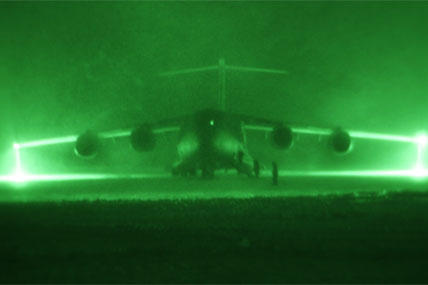JOINT BASE LEWIS-MCCHORD, Wash. -- Despite operating in harsh conditions and experiencing multiple weather delays, the 304th Expeditionary Airlift Squadron, comprised of Airmen from the 62nd and 446th Airlift Wings at McChord Field, completed its winter flying period into McMurdo Station, Antarctica Aug. 29, in support of the U.S. Antarctic Program and the National Science Foundation.
During the period, known as WinFly, crews completed six missions aboard a C-17 Globemaster III aircraft. The aircraft was deployed from McChord Field and delivered 319 passengers and more than 230,000 pounds of cargo to the remote, icy airfield. Additionally, 69 passengers and more than 35,000 pounds of cargo were transported out of McMurdo.
Using Christchurch International Airport, New Zealand as the base of operations, the mission of WinFly is to deliver advance teams and cargo to the remote research center in preparation for the main season of Operation Deep Freeze.
During the period leading up to main season, the research center will swell from approximately 150 NSF and support personnel to roughly ten times that size, helped largely by the efforts of the 304th EAS, said Lt. Col. Brent Keenan, the 62nd Operations Group deputy commander and ODF commander.
These operations are unlike any other U.S. military operations and present unique challenges for all members involved.
Weather and visibility are the two major factors which increase the difficulty of the mission, said Capt. Rok Dedic, 62 AW instructor pilot and one of the pilots involved in the missions.
"In Antarctica, the weather changes at a moment's notice," said Dedic.
The unpredictable weather caused the first mission into McMurdo to be aborted after takeoff.
"The weather was good, we launched our mission and by the time we reached our point of safe return, we had to turn around and come back to Christchurch due to a change in weather," said Dedic.
Despite the delays, the crews completed all six missions just slightly behind the estimated completion time.
"The weather support team did an excellent job analyzing weather trends to assist in determining the best launch times," said Keenan. "The 304th maintenance team also did an outstanding job keeping the jet mission capable," said Keenan.
The final five missions were completed over the span of just 86 1/2 hours and only 16 1/2 of those hours were spent on the ground at Christchurch, said Keenan. This shows how well the weather and maintenance teams worked to ensure the aircraft had minimal downtime.
In addition to delivering NSF personnel and cargo into and out of McMurdo, the 304th EAS also completed valuable training to include seven pilots getting trained and certified to perform nighttime landings at McMurdo using night vision goggles.
"This training has better equipped us to perform emergency support operations for the NSF during the winter months," said Keenan.

























